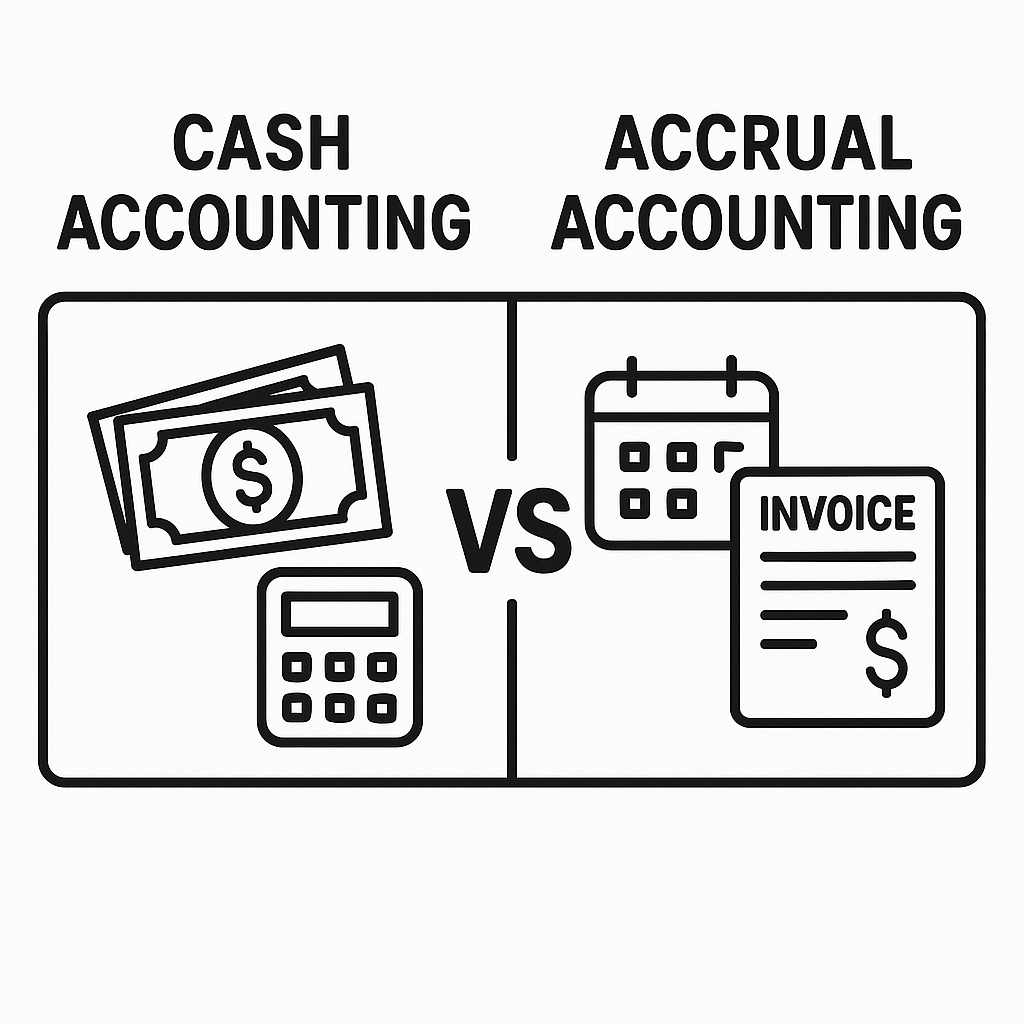Cash vs Accrual There are two “time-frames” or basis methods to do bookkeeping and accounting in: Cash Basis and Accrual Basis.
| Cash Basis | Accrual Basis |
|---|---|
| Income recorded when cash is received | Income recorded when earned (even if not paid) |
| Expenses recorded when paid | Expenses recorded when incurred |
| Easier for small businesses | Required for some larger entities |
💡 Cash vs Accrual Accounting Example:

If you invoice a client in June but get paid in July:
- Cash accounting → record income in July directly from Bank Feed upon cash receipt
- Accrual accounting → record income via Invoice in June, then match bank deposit to invoice in July after cash is received
Usually the type of business will determine whether or not Accrual accounting is necessary, but in most small businesses Cash Basis is the primary accounting method.
Accrual Basis comes into play when more detail is needed. At a certain size, a company may be legally required to maintain accrual books. Even before that, having functions like Accounts Payable (AP) and Accounts Receivable (AR) can help businesses understand and project their cash flow with better timing and clarity.
A great example of where accrual basis accounting is useful would be Commercial Real Estate. If the business only tracked physical cash, the reports wouldn’t reflect unpaid rent, CAM, or other receivables. Cash Basis would only show what was received or spent — not what is owed.
The course I teach at www.learnaccountingbasics.com uses Cash Basis as the foundation, since that’s what most small business owners use to get started with their own bookkeeping. If you want to walk through your specific situation, book a free call at www.jptechnologyconsulting.com to get started with your business books!
When Should You Make the Switch?
Understanding when to transition between these accounting methods is crucial for growing businesses. The IRS requires certain companies to use the accrual method based on specific criteria. If your business has gross receipts averaging more than $29 million over the past three years, you’re generally required to adopt this approach. Additionally, C corporations with assets exceeding $10 million must also follow accrual principles.
However, the decision to switch shouldn’t be based solely on legal requirements. Many businesses find that tracking income when earned and expenses when incurred provides better financial insights long before they reach these thresholds. When your business begins extending credit to customers or taking on significant accounts payable, this comprehensive approach becomes invaluable for understanding your true financial position.
The Impact on Financial Reporting and Decision Making
Your choice of accounting method significantly affects how your financial statements reflect business performance. The cash method provides a straightforward view of actual cash flow, making it excellent for businesses that primarily deal in immediate transactions. However, this simplicity can mask important financial trends and obligations.
The accrual method paints a more comprehensive picture of your business’s financial health. By recording income when earned and expenses when incurred, regardless of when money changes hands, you get a clearer view of profitability and financial obligations. This timing difference is particularly important for businesses with seasonal fluctuations or long payment cycles.
For example, a construction company using the cash method might appear highly profitable in months when large payments are received, even if the actual work was performed months earlier. The same company following accrual principles would show more consistent profitability patterns that align with actual business activity.
Tax Implications of Different Accounting Methods
The timing differences between these two approaches create significant tax planning opportunities and considerations. The cash method allows for more direct control over when income and expenses are recognized for tax purposes. You can potentially defer income to the following tax year by delaying invoicing or accelerate deductible expenses by paying bills before year-end.
The accrual method requires more sophisticated tax planning strategies since income and expenses are recognized when earned or incurred, not when money is exchanged. This approach often requires businesses to pay taxes on income they haven’t yet received, which can create cash flow challenges if not properly managed.
Many businesses find that working with a qualified accountant becomes essential when operating under accrual principles, as the complexity of timing issues and tax implications requires professional expertise to navigate effectively.
Best Practices for Implementation
Whether you choose the cash method or accrual approach, consistent implementation is key to accurate financial reporting. For cash-based bookkeeping, maintain detailed records of all transactions and ensure that bank reconciliations are performed regularly. This method works particularly well with modern accounting software that can automatically import and categorize bank transactions.
For accrual-based bookkeeping, establishing robust invoicing and bill management systems becomes critical. You’ll need processes for tracking accounts receivable, managing accounts payable, and ensuring that all transactions are recorded in the correct accounting period regardless of when money is received or paid.
The transition between accounting methods should be carefully planned and often requires professional assistance to ensure compliance with accounting standards and tax regulations. Many businesses benefit from running parallel systems during the transition period to ensure accuracy and completeness.